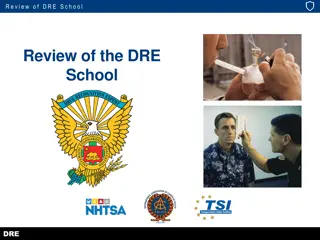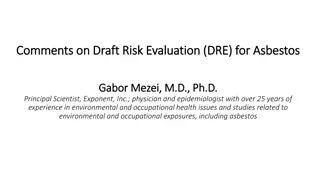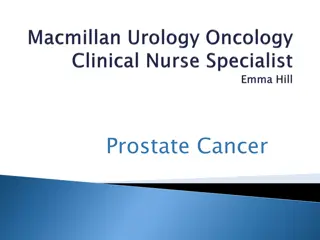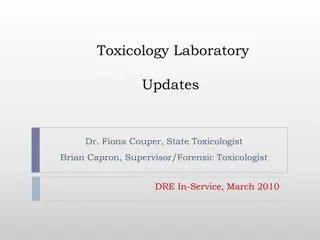
Development and Effectiveness of Drug Evaluation and Classification Program (DRE)
Explore the evolution, research, and validation of the Drug Evaluation and Classification Program (DRE) in Session 3. Discover the LAPD development, NHTSA collaboration, standardized procedures, and two stages of research. Gain insights into the identification of drug influence, psychoactive impairment, and the need for medical intervention.
Download Presentation

Please find below an Image/Link to download the presentation.
The content on the website is provided AS IS for your information and personal use only. It may not be sold, licensed, or shared on other websites without obtaining consent from the author. If you encounter any issues during the download, it is possible that the publisher has removed the file from their server.
You are allowed to download the files provided on this website for personal or commercial use, subject to the condition that they are used lawfully. All files are the property of their respective owners.
The content on the website is provided AS IS for your information and personal use only. It may not be sold, licensed, or shared on other websites without obtaining consent from the author.
E N D
Presentation Transcript
S e s s i o n 3 D e v e l o p m e n t & E f f e c t i v e n e s s o f t h e D E C P r o g r a m Session 3 Development and Effectiveness of the Drug Evaluation and Classification Program DRE
S e s s i o n 3 D e v e l o p m e n t & E f f e c t i v e n e s s o f t h e D E C P r o g r a m Learning Objectives State origin and evolution of DEC Program Describe DEC Program research and validation Discuss DEC Program acceptance in the courts DRE 3 - 2
S e s s i o n 3 D e v e l o p m e n t & E f f e c t i v e n e s s o f t h e D E C P r o g r a m LAPD Developed DRE DRE 3 - 3
S e s s i o n 3 D e v e l o p m e n t & E f f e c t i v e n e s s o f t h e D E C P r o g r a m LAPD and NHTSA Developed and validated SFSTs for alcohol-impaired driving By early 1980 s NHTSA began to assist LAPD in validating DRE program DRE 3 - 4
S e s s i o n 3 D e v e l o p m e n t & E f f e c t i v e n e s s o f t h e D E C P r o g r a m The DRE Process DRE 3 - 5
S e s s i o n 3 D e v e l o p m e n t & E f f e c t i v e n e s s o f t h e D E C P r o g r a m Reasons for Standardized Procedure Articulate suspicion of drug influence Subject may refuse testing Identify psychoactive impairment Reduce testing costs Identify need for medical intervention DRE 3 - 6
S e s s i o n 3 D e v e l o p m e n t & E f f e c t i v e n e s s o f t h e D E C P r o g r a m Two Stages of Research Laboratory Evaluation Johns Hopkins University Field Evaluation Los Angeles DRE 3 - 7
S e s s i o n 3 D e v e l o p m e n t & E f f e c t i v e n e s s o f t h e D E C P r o g r a m Laboratory Evaluation Johns Hopkins University DRE 3 - 8
S e s s i o n 3 D e v e l o p m e n t & E f f e c t i v e n e s s o f t h e D E C P r o g r a m Laboratory Evaluation Diazepam Secobarbital d-amphetamine Marijuana DRE 3 - 9
S e s s i o n 3 D e v e l o p m e n t & E f f e c t i v e n e s s o f t h e D E C P r o g r a m Laboratory Evaluation DRE officers correctly identified 95% of drug-free subjects as "unimpaired" DRE officers classified 98.7% of high-dose subjects as "impaired" Correctly identified category of drugs for 91.7% of high-dose subjects DRE 3 - 1 0
S e s s i o n 3 D e v e l o p m e n t & E f f e c t i v e n e s s o f t h e D E C P r o g r a m Laboratory Evaluation DRE officers were less successful in classifying low- dose subjects 17.5% of d-amphetamine impaired 32.5% of weak marijuana impaired DRE 3 - 11
S e s s i o n 3 D e v e l o p m e n t & E f f e c t i v e n e s s o f t h e D E C P r o g r a m Field Evaluation Los Angeles DRE 3 - 1 2
S e s s i o n 3 D e v e l o p m e n t & E f f e c t i v e n e s s o f t h e D E C P r o g r a m Field Evaluation Los Angeles Blood tests confirmed: One suspect had no drugs or alcohol 10 had alcohol only 37 (21%) had one drug other than alcohol 82 (47%) had two drugs (including alcohol) 43 (25%) had three or more drugs (including alcohol) DRE 3 - 1 3
S e s s i o n 3 D e v e l o p m e n t & E f f e c t i v e n e s s o f t h e D E C P r o g r a m Toxicology Results for Specific Categories 92%: Phencyclidine (PCP) 85%: Narcotic Analgesics 78%: Cannabis 50%: CNS Depressants 33%: CNS Stimulants DRE 3 - 1 4
S e s s i o n 3 D e v e l o p m e n t & E f f e c t i v e n e s s o f t h e D E C P r o g r a m DEC Program Acceptance Frye Standard Is the procedure or principle espoused, accepted by the relevant scientific community? DRE 3 - 1 5
S e s s i o n 3 D e v e l o p m e n t & E f f e c t i v e n e s s o f t h e D E C P r o g r a m DEC Program Acceptance Daubert Standard Shows reliability before scientific evidence can be admitted DRE 3 - 1 6
S e s s i o n 3 D e v e l o p m e n t & E f f e c t i v e n e s s o f t h e D E C P r o g r a m DEC Program Acceptance Frye Standard Arizona v Johnson Colorado v Hernandez Minnesota v Klawitter Washington v Baity DRE 3 - 1 7
S e s s i o n 3 D e v e l o p m e n t & E f f e c t i v e n e s s o f t h e D E C P r o g r a m DEC Program Acceptance Daubert Standard New Mexico v Aleman Nebraska v Daly DRE 3 - 1 8
S e s s i o n 3 D e v e l o p m e n t & E f f e c t i v e n e s s o f t h e D E C P r o g r a m Horizontal Gaze Nystagmus Case Law Arizona v Blake DRE 3 - 1 9
S e s s i o n 3 D e v e l o p m e n t & E f f e c t i v e n e s s o f t h e D E C P r o g r a m Questions? DRE 3 - 2 0
S e s s i o n 3 D e v e l o p m e n t & E f f e c t i v e n e s s o f t h e D E C P r o g r a m Test Your Knowledge 1. State four reasons why it is important not to rely simply on a chemical test to establish a subject s impairment. 2. What categories of drugs were included in the Johns Hopkins Evaluation? 3. In what percentage of cases in the Los Angeles Field Evaluation did blood tests support the DREs opinion PCP was present? DRE 3 - 2 1
S e s s i o n 3 D e v e l o p m e n t & E f f e c t i v e n e s s o f t h e D E C P r o g r a m Test Your Knowledge 4. What percentage of blood tests in the LAPD Field Evaluation supported the presence of at least one drug category identified by the DREs? 5. What was the landmark State Supreme Court case that upheld the use of HGN as evidence of impairment? 6. Which landmark expert testimony court decision requires the court to have a gate-keeper role and screen evidence? DRE 3 - 2 2
















